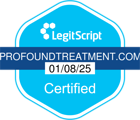Dangers of Mixing Tramadol and Alcohol
What is Tramadol?
Tramadol is an opioid analgesic classified as a Schedule IV drug. Schedule IV drugs are associated with a low potential for abuse and dependence. While they are not as addictive as some drugs, a dependency can form if the drug is abused, especially if it is mixed with other substances such as alcohol. 1

Contact Profound Treatment to Learn More
Our team is standing by to discuss treatment options with you. Your call is completely confidential and no obligation is required.
Street Names for Tramadol
- Chill Pills
- Tramal
- Trammies
- Ultras
Scope of Tramadol Use
Is Tramadol Addictive?
- In some instances, a person may feel that the amount of Tramadol they’ve been prescribed is not doing enough to relieve pain. They may increase their dose and begin building a tolerance that fuels addiction and dependence.
- A mood or mental disorder can also lead to Tramadol abuse. The drug may produce a soothing effect that relieves mental health symptoms, and some may use the substance to self-medicate.
- Someone may begin taking Tramadol for recreational purposes because they enjoy its effects and then develop a potential addiction.
Is Tramadol Safe?
Dangerous Drug Interactions
Tramadol and alcohol are a dangerous combination as well, as both are central nervous system depressants. Mixing opioids and alcohol can have suppressive effects on blood pressure, respiration, and heart rate. The slowing down of these functions can lead to organ damage or even death.
How is Tramadol Used?
Is Tramadol an Opioid?
Is Tramadol a Narcotic?
Side Effects of Tramadol
Short-Term Effects
- Elevated mood
- Difficulty sleeping
- Anxiety reduction
- Loss of appetite
- Sweating
- Dry mouth
- Tremors
- Nausea
- Constipation
- Diarrhea
- Headache
Long-Term Effects:
- Alzheimer’s
- Parkinson’s
- Seizures
- Serotonin syndrome
What Happens When You Mix Tramadol and Alcohol?
- Overdose: Mixing opioids and alcohol can slow down vital functions causing an overdose.
- Atypical Responses: Atypical responses mean the person may not act in a predictable fashion as compared to how they would act if they took only Tramadol or alcohol alone. The unpredictability can lead to dangerous situations.
- Poor Judgment: A painkiller and alcohol combination enhances feelings of well-being, resulting in poor judgment that increases the risk of dangerous behavior.
- Physical Dependence: Taking chronic pain medication and drinking makes the body used to having the drugs in its system. When the drugs are not present, the body is unable to function properly.
Tramadol Addiction Treatment
Detox
Detox is typically the first step in treating alcohol and opioids. It requires allowing the body to rid itself of illicit substances. Withdrawal symptoms will appear, but medical staff at a treatment clinic will oversee the process and take measures to keep the patient as comfortable as possible.
Rehabilitation
- Inpatient treatment requires the patient to stay in the clinic 24/7 for a set period of time, usually one to three months. They will undergo detox and therapy.
- Outpatient treatment requires the patient to split their time between therapy and everyday life. It can be the primary form of care, or it can be a follow up to inpatient care. Patients typically start with partial hospitalization which involves six to eight hours a day of therapy. Eventually, that will taper off to just a few therapy sessions a week.
Therapies
Get Help With Profound Treatment
If you or a loved one are struggling with Tramadol and alcohol addiction, or any other form of dependence, we are here to help. There are many facilities that offer Tramadol and alcohol treatment, but Profound Treatment takes an approach that sets us apart. We offer an evidence-based model based on psychology, medicine, and neuroscience.

Reach Out and Begin Your Sobriety Journey
Addiction can be scary, but you don’t have to go through it alone. Call Profound Treatment today and we will help you take the steps you need to move forward.
Resources
- 1https://www.deadiversion.usdoj.gov/drug_chem_info/tramadol.pdf
- 2https://www.ncbi.nlm.nih.gov/pmc/articles/PMC7271275/
- 3https://go.drugbank.com/drugs/DB00193
- 4https://www.fda.gov/drugs/postmarket-drug-safety-information-patients-and-providers/tramadol-information
- 5https://pubmed.ncbi.nlm.nih.gov/31721720/#:~:text=Long%20term%20utilization%20of%20tramadol,inhibitory%20effects%20on%20GABA%20receptors.
Useful Links
Licensed by the State Department of Health Care Services.
Profound Healing Centers License No: 191092BP Exp. 5/31/26 (current/active)
Profound Healing Centers License No: 191092AP Exp. 7/31/25 (current/active)
Profound Treatment License No: 191047CP Exp. 1/31/27 (current/active)
Profound Treatment License No: 191047AP Exp. 8/31/26 (current/active)
Profound Treatment License No: 191047EP Exp: 3/31/26 (current/active)
Profound Treatment License No: 191047DP Exp. 9/30/25 (current/active)
Click here for more information about DHCS licensing.








